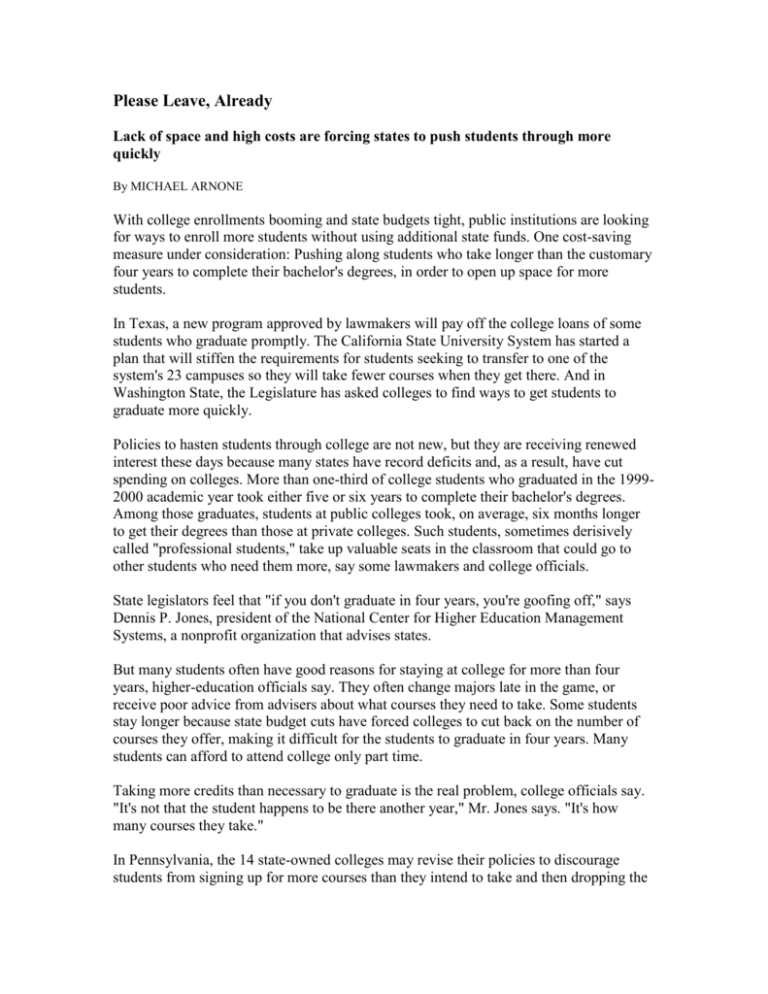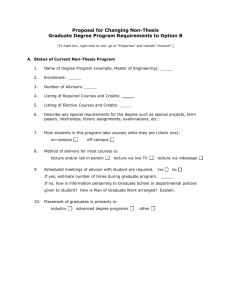Please Leave, Already
advertisement

Please Leave, Already Lack of space and high costs are forcing states to push students through more quickly By MICHAEL ARNONE With college enrollments booming and state budgets tight, public institutions are looking for ways to enroll more students without using additional state funds. One cost-saving measure under consideration: Pushing along students who take longer than the customary four years to complete their bachelor's degrees, in order to open up space for more students. In Texas, a new program approved by lawmakers will pay off the college loans of some students who graduate promptly. The California State University System has started a plan that will stiffen the requirements for students seeking to transfer to one of the system's 23 campuses so they will take fewer courses when they get there. And in Washington State, the Legislature has asked colleges to find ways to get students to graduate more quickly. Policies to hasten students through college are not new, but they are receiving renewed interest these days because many states have record deficits and, as a result, have cut spending on colleges. More than one-third of college students who graduated in the 19992000 academic year took either five or six years to complete their bachelor's degrees. Among those graduates, students at public colleges took, on average, six months longer to get their degrees than those at private colleges. Such students, sometimes derisively called "professional students," take up valuable seats in the classroom that could go to other students who need them more, say some lawmakers and college officials. State legislators feel that "if you don't graduate in four years, you're goofing off," says Dennis P. Jones, president of the National Center for Higher Education Management Systems, a nonprofit organization that advises states. But many students often have good reasons for staying at college for more than four years, higher-education officials say. They often change majors late in the game, or receive poor advice from advisers about what courses they need to take. Some students stay longer because state budget cuts have forced colleges to cut back on the number of courses they offer, making it difficult for the students to graduate in four years. Many students can afford to attend college only part time. Taking more credits than necessary to graduate is the real problem, college officials say. "It's not that the student happens to be there another year," Mr. Jones says. "It's how many courses they take." In Pennsylvania, the 14 state-owned colleges may revise their policies to discourage students from signing up for more courses than they intend to take and then dropping the least attractive one, which can block other students from those courses. Full-time students currently pay a flat tuition rate to take between 12 and 18 credits, and pay an extra $192 for every credit beyond 18. The proposed change would lower that threshold to 16 credits a semester. But officials also note that the policy may deter students from taking a heavier courseload and graduating early. As a result, the idea was put on hold in January pending further study. College officials have mixed opinions about how well such punitive policies work, especially if they discourage students from graduating early by taking extra credits. What appears to work better is offering students information and advice on how to not take unnecessary courses in the first place. One of the first states to develop policies to encourage students to graduate on time was Florida. The University of Florida started a program in 1996 that guarantees a slot in any course required for a student's major. Students can track their academic records online and see how long it would take them to graduate if they changed majors. The university saw its four-year graduation rate jump from 38 percent to 50.8 percent between 1990 and 2002, says David R. Colburn, the university's provost. The increase was the result of better planning by students, not heavier courseloads. Indeed, the average number of credit hours per student increased to only 13.5 a semester from 13.1. The success of the program at the University of Florida led Florida State University to start a similar program this semester with selected majors. The new program is scheduled to apply to all majors beginning next fall. Still, taking all the required courses in the proper order can be tricky, says Julie M. Halladay, a University of Florida senior who graduated in December, a semester late. She added a second major, Spanish, to her public-relations major too late, making it almost impossible to graduate in four years. "If I had known from the get-go, I think I could have done it in four years," she says. But "if you decide too late, there's no way you can." But students in Florida may soon have a painful incentive to find one. Gov. Jeb Bush, a Republican, has proposed that students pay out-of-state tuition if they take more than the minimum number of courses to graduate. Remediation Slows Students In California, the governor, Arnold Schwarzenegger, a Republican, has proposed a similar measure for students who may want to linger in college. With a $14-billion deficit and a growing college population, California's public colleges are under pressure to find room for more students. "The only way to get more spaces is to graduate more students with fewer credits," says David S. Spence, vice chancellor and chief academic officer at California State University. The system's Board of Trustees has adopted a plan to increase the graduation rate and help students graduate with fewer credits. The system has yet to decide what penalties, if any, it will impose on noncompliant students, Mr. Spence says, but the punishments may include higher fees. Under the plan, Cal State will standardize majors by limiting each one to between 45 and 60 required credits. Students will also have to declare their majors by the end of their freshman year. In addition, the university is revising its transfer requirements. To transfer, students will need to complete all general-education requirements, declare a major, and finish all prerequisite courses for that major by the time they have earned 60 credits. The students will have to select the campus they want to attend by the time they have earned 45 credits instead of 60. The university will also help students plan their majors to graduate as quickly as possible. A large percentage of extra credit hours come from students taking remedial courses, Mr. Spence says. In the fall of 2002, 59 percent of incoming Cal State freshmen, about 22,370 students, needed remedial instruction in either math or English. The university has created an exam for high-school juniors to make sure that they have sufficient knowledge of English and math before they enroll. He expects that the test, which all California high schools are required to administer starting next year, will cut in half the number of students taking remedial courses over the next three years. Texas Deal Beginning in January, students in Texas have a new incentive to graduate early: The state will forgive their loans. To be eligible for the program, dubbed Texas-B-on-Time, students must have financial need and have taken a college-preparatory curriculum in high school. If they qualify, the state will provide them with zero-interest loans to cover the average annual cost of tuition, fees, books, and room and board. To keep their loans, students must maintain a 2.5 grade-point average in college and complete at least 75 percent of their credit hours each semester. Students who have earned more than 150 credit hours are ineligible for additional loans through the program. Students can have their loans forgiven if they keep their grades up or graduate on time. At four-year institutions, students must have graduated with at least a 3.0 grade-point average in four or five years, depending on the length of their academic program, or have taken no more than six credit hours above the minimum necessary for their majors. Students at community colleges must graduate in two years. At all colleges, participants who do not meet the forgiveness criteria can still keep their zero-interest loans. That is, if the state has enough money to pay for the program. State officials project that 12,000 to 15,000 students could take advantage of the program in 2003-4, and the same next year. But the program received roughly $47-million in the state's two-year budget for 2003-5, far less than the estimated $200-million needed to meet all the demand. Students with the most financial need will get the loans first until the money runs out. Lois P. Hollis, assistant commissioner for student services at the Texas Higher Education Coordinating Board, fears that many people excited about the program will not be chosen for it. The program may also end up serving fewer students than intended, Ms. Hollis says, now that public colleges in the state have authority to set their own tuition rates. If colleges raise their prices, as expected, the state will have to cover those tuition increases for students in the program. http://chronicle.com Section: Government & Politics Volume 50, Issue 22, Page A20



